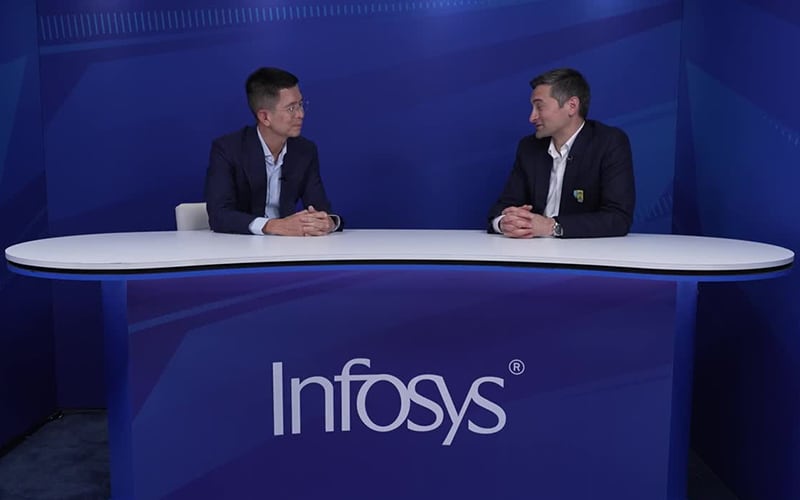An evolving landscape
The experience landscape looks markedly different today than it did a decade ago.
It has been reshaped by the tremendous success of design thinking, enabling the creation of products and services that better serve both customer expectations and business needs.
Design thinking’s user-centric approach has enabled experiences that are more effective and more intuitive, and that make lives simply better.
Design thinking is evidence based, using data analysis and user research to inform decisions. It has transformed the design process: making it objective, accountable, and transparent. Designers have progressively aligned their efforts to business objectives, while business leaders have grown to understand that the design-led approach to problem solving brings enormous value.
The past decade has witnessed the transformative power of design thinking as design-led organizations have outperformed their competitors, becoming leaders in their respective industry verticals. This success has driven a profound change in the operational landscape: design excellence matters, to customers, employees, and even shareholders. At the same time, design thinking is reaching the point of diminishing returns as more companies adopt it and new challenges emerge. Designers need a new approach if the current momentum is to be maintained and if the growing expectations and responsibilities of the industry are to be met.
These changes can be understood in terms of three macro-level challenges, which will affect all organizations in the decade ahead:
Change is the only constant
The accelerating pace of innovation is disrupting established business models. In an environment where change is the only constant, organizations require an unprecedented level of business agility to operate successfully. Our experience working with some of the world’s largest companies, responding to complex real-word challenges, has shown us that the existing linear approach to developing products and services is no longer fit for purpose. Even with Agile delivery methods, projects take too long to move between iterations and cannot keep pace with changing requirements. A new approach is required: one that embraces the new reality and enables us to shape experiences that can respond to change on a continuous basis.
An evolving consumer
The relentless growth in consumer expectations from digital services is challenging organizations to deliver increasingly better experiences. This is now transcending the traditional barrier between the consumer space and the enterprise space. We are no longer willing to accept experiences in our working lives that are significantly worse than the experiences we have become familiar with as consumers.
To add complexity to the matter, as our society undergoes a cultural drive toward individualism that celebrates diversity, traditional methodologies that assign people to broad demographic groupings don’t provide the level of granularity needed to address this adequately. While organizations working in the consumer space can attempt to address this diversity by targeting ever-more specific customer segments, our clients in the enterprise space cannot. We need new methods that allow organizations to address a diverse range of very different user needs with the same depth of understanding.
Growing appetite for evidence
As experience is becoming the differentiating factor for service-oriented organizations, it has become a driving force of value creation. Our experience of working with large organizations has shown us that they are no longer willing to take decisions on the basis of consultants’ opinions or industry “best practice.” Quite rightly, our clients demand evidence of the value that a given design decision delivers against business objectives. The user research methodologies that have served us well until now need to be supercharged to respond to the increased level of demand placed on them. And we must ensure that this desire for evidence is not allowed to impede creative thinking and innovation.
Designing effective products and services in this context is a complex, multidimensional challenge that requires bold, innovative new answers.
The new paradigm
We have seen firsthand that current methods of designing digital experiences, which rely exclusively on the creative and analytical abilities of designers, are limited in their ability to solve design challenges to their full potential.
This is a missed opportunity for both consumers and businesses, as consumer’s expectations are not met and businesses miss the chance to create value by meeting those expectations: a lose-lose scenario.
The computational power of technology augments and amplifies designers’ problem-solving abilities, breaking through the current limitations. The goal is not to replace people with technology, but to use technology where it outperforms humans — in data processing and algorithmic calculations — and allow designers to focus on what they are best at — innovation, creative thinking, and emotional intelligence.
Computational design enables us to address the three macro-level challenges identified above and represents a pivotal change to the way things are designed.
Our approach is structured on three core principles of computational design that, when adopted together, enable designers and businesses to be best prepared to address these challenges.
Design adaptable
To address the challenge of an ever-changing landscape, common perspectives toward change must evolve.
The current tenet that sees change as a risk to be mitigated needs to give way to a new paradigm that sees change as an opportunity to embrace. Design solutions will need to be adaptable at their core. Reacting to change in a fast, frictionless, and cost-effective way enables organization to attain the business agility required to succeed.
Design inclusive
To address the complexities of an evolving consumer base, the way businesses understand, segment, and target users must evolve. The current tenet that sees a design solution as a single, best thing will have to give way to a new paradigm that sees design manifest itself in a thousand variants, each tailored to the user on the basis of a deep understanding of who they are. Computational design can thus serve each user with a tailored experience that matches their needs and expectations.
Design measurable
To address the growing importance of evidence-based decision making, approaches to measurement must evolve. The current tenet that sees measurement as an activity undertaken well after a design solution has been deployed will have to give way to a new approach that sees measurement as core to design, built into its DNA from inception. Defining what success looks like through unambiguous key performance indicators (KPIs) will become one of the first activities designers engage with. These KPIs will enable continuous measurement of the effectiveness of design solutions, thus leading to a shift in decision making from opinion to tangible, objective evidence.
Experience is the new frontier of value-creation, a frontier that is in constant motion.
In this landscape organizations will create value by adopting the principles of computational design: adaptive, inclusive, measurable — delivering experiences that meet customers’ growing expectations and leading to better business outcomes.
Organizations that embrace this new reality will adopt an optimal posture to become the leaders of tomorrow.
Organizations that discount this challenge and fail to adapt will see their business models challenged, and will be relegated to become the laggards of tomorrow.

Mission
As we embark on this journey, we have an opportunity to chart a new path.
In doing so, we will not look backwards, attempting to solve the problems of the past in a revisionist fashion.
Instead, we will look forward, preparing ourselves to take on the challenges of the future, beyond the current line of sight.
Our objective is to develop a comprehensive approach that guides both designers and decision makers within organizations throughout this journey.
We are excited that this paper could help catalyze a movement of like-minded people who will shape the next generation of experiences. These experiences, driven by computational capabilities, will be better for customers and will deliver better business outcomes.
Introducing Computational Design

Overcoming limits to design
Designing successful digital experiences involves deeply understanding people, creating a number of different ideas, and assessing the success of these ideas. All three of these activities are currently limited by designers’ capacity for computation, but technology can help to overcome these limits.
In the field of architecture, computational and generative design technologies have been used to model and shape some of the world’s most impressive buildings — masterpieces that were not possible to conceive of and build before these capabilities were developed.
Another example is in the fiercely competitive field of motorsports. Computational technologies have been used to model how minimal changes to the aerodynamics of a vehicle affect its performance in a variety of scenarios and conditions. These improvements can be marginal in isolation, but their cumulative effect results in a competitive advantage that defines winners and losers in a real-world racing scenario.
In both examples, computational capabilities have dramatically disrupted their respective industries, changing not only the final, designed product but also the ways of working — the expectations and skills — to operate successfully in this space. The result has not been a replacement of the human element with the machine but rather an augmentation, helping architects and engineers reach new levels of creativity.
Computational design capabilities are only beginning to be realized in the field of experience design. It can unlock the tremendous creative potential of people, helping overcome current limits in understanding, creativity, and analysis of design challenges.
Overcoming limits to understanding
As designers, we begin the design process by identifying a problem to solve. We do this by developing a thorough understanding of the people who use a product or service. What kind of people are they? What are their motivations for using the product or service? What needs does the product or service address?
This activity is currently limited by designers’ ability to conduct reliable research, interpret data correctly, and infer correct conclusions. In the past decade, we have made great progress in the field of user experience research. The field applies much-needed scientific rigor so that design decisions are based on reliable evidence. However, we are now discovering new limits caused by the nature of data itself.
Looking outside of the field of design, we can see how machine-learning systems discover and act upon hidden patterns in large data sets, well beyond the human capacity to compute and process large amounts of information. Applying these technologies and learning to experience design will help us unlock a much deeper understanding of end consumers of the products and services we shape on a daily basis.
Overcoming limits to creativity
Once we have identified a problem to solve, we switch to a creative process: generating different ideas that could potentially solve the problem. We encourage innovative thinking and a diversity of problem-solving approaches to try to discover combinations of ideas that have never been conceived of before.
This creative ability is our greatest power: being able to transform products, services, and entire organizations for the better. However, we are currently limited by our human capacity to conceive of and maintain multiple ideas simultaneously. While at a conceptual level multiple different ideas can be imagined and assessed successfully, the closer we get to creating real things. The number of design decisions we must make grows exponentially. Our ideas then become entangled in an ever-growing tree of dependencies. Faced with such complexity, designers can only revert to best practice, rules-of-thumb, and intuition, instead of genuine creativity.
Computational capabilities allow us to create many more variants of a proposed solution than any designer can conceive of, then put these variants in competition with each other to determine which are the most successful. Other creative fields such as architecture and advanced engineering have been using these capabilities for some time, and we are excited to learn from these examples.
Overcoming limits to analysis
Finally, we must assess the range of potential solutions we have created in light of our understanding of users’ needs and business objectives, to select which of them are most likely to succeed.
As designers, we have learned to be very good at critique: analyzing the quality of creative work against a set of defined objectives. But this ability can be highly subjective, and can vary in effectiveness from person to person. Our ability to assess the effectiveness of our work is limited by our ability to conduct reliable analysis, interpret data, and infer conclusions from it.
In the field of engineering, systems have been designed that continuously monitor and adjust themselves to maintain optimal efficiency, augmenting engineers’ ability to explore new functionality in unpredictable situations.
Applying this technology to experience design, we can build self-monitoring experiences with analytics and testing capabilities built in from the start. This will enable us to assess the effectiveness of our proposed solutions more quickly and accurately than ever before, reducing the separation between proposing a solution and assessing its effectiveness.
The entire traditional design process is limited by having to conduct these activities as discrete tasks, often done by separate people over a prolonged period of time, and usually characterized by problematic handovers. This limits an organization’s ability to respond to unpredictable and variable situations that are the hallmark of the operational environment where change is the only constant.
By building a capability that connects the understanding, creative, and analytic activities into a single interconnected system, we can break through these limitations and respond better to the challenges of the new paradigm.
The new way of designing things
Introducing a computational dimension in the design process will catalyze a new generation of experiences — computational experiences — and a new approach to solving users and business problems.
This new way of designing things rests on four foundations.
A new model to understand users
Following the tenets of traditional design methodologies, experience designers use personas to try to understand users. This technique involves creating an imaginary character as a surrogate for real people to assess the effectiveness of design ideas.
Despite designers’ best efforts to base personas on reality, the technique is deeply flawed. Personas encourage designers to see users as a homogenous stereotype instead of a diverse population of individuals, and anyone who doesn’t fit the stereotype is ignored. Personas also encourage us to make things up: fleshing out details to make our imaginary characters feel more real.
Computational design enables us to interpret, codify, and measure the behavior of a diverse group of real users in real-time at a granular level. It eliminates the need to rely on personas as a proxy for users; instead, we can design products using data from real users. Designers can then enrich their understanding of these users by drawing on established academic research 1, 2 to consider each individual user’s needs, motivations, aspirations, and concerns.
The process is continuous and fully automated. It uses computational technology to discover correlations between psychometric data and telemetry data, and define behavioral indicators of user characteristics. We call these key sentience indicators (KSIs) to differentiate them from the KPIs we use to measure success.
A codified design language
To apply the power of computation to the design of products and services, designers need to define experiences in a way that computers can understand: codified as information rather than aesthetics.
We have developed a schema — a structured model of information that we use to define the structure, style, and content of an interface. Experiences defined in this way can be manipulated by algorithms, morphing into multiple variants in response to data inputs. Hundreds of subtly different variants can be generated without the need to produce endless design visuals.
This marks a shift from the creation of a single monolithic experience dictated entirely by a designer, to a continuously evolving, “live” experience that is directed by a designer.
A process of continuous measurement
To meet the demand for evidence-based design, solutions must have a codified element of measurability built into their DNA from the start.
This measurability enables a process of continuous assessment of the efficacy of a given design solution in a real, live context. Analysis and testing become part of the design process itself. Designers no longer have to base their assessment of design ideas on intuition and guesswork, or on imperfect prototypes tested in artificial situations.
Computational design enables a shift toward data-driven decision making. Solutions are objectively — rather than subjectively — assessed, and unconscious bias is minimized.
An integration-first approach
Computational design turns the traditional workflow on its head. Instead of integrating a design solution into a technical architecture after all design decisions have been made and an experience created, the solution is integrated first.
Developers work out how our product interacts with back-end systems before the experience has been designed. This up-front integration work means that design ideas can be rendered instantly into the product, with all of the connections to back-end systems already in place.
This shift from a linear, sequential development process to a continuous deployment capability means there is almost no delay between proposing a design idea and assessing its success. Designers no longer have to weigh the costs and benefits of implementing design ideas. We can propose any number of design ideas, and test them directly in the product.
Democratizing the capability

The idea of applying computational design capabilities in the context of experience has circulated in the industry for a while.
So far, however, a practical, implementable solution remains elusive.
Our journey toward the development of a computational design capability did not start as a matter of philosophy but rather as one of pragmatic necessity. Mandated by Nandan Nilekani, co-founder and non-executive Chairman of Infosys, to shape an employee experience that was truly inclusive for all of employees, we soon realized that traditional methodologies would not enable us to realize this ambition to its full potential. This challenge has driven us to disrupt our previous thinking and has ensured that our effort is firmly anchored toward a pragmatic implementation of the capability within a real-world scenario.
We believe that the tremendous potential of this capability transcends our effort to shape a next-generation employee experience and is applicable to the wider industry engaged in shaping experiences and services. Confident of our early success, we intend to democratize this capability in the shape of a new software as a service (SaaS) platform we have developed: Elyo.
As a leading design and innovation studio working in partnership with one of the world’s leading system integrators, we have the practical understanding of the challenges required to develop and integrate this sophisticated capability into the existing technology stack of prospective adopters, while maintaining the lightest footprint possible.
We are working to lower the investment and technological barriers, driving adoption across industry segments that would otherwise not have the financial and technical firepower to develop and maintain a proprietary computational design capability themselves.
In doing so, we aim to catalyze a movement within the industry and bring these capabilities to a wider range of designers and decision makers.
The case for adoption

Organizations that adopt computational design have the potential to gain tremendous value — unlocking untapped opportunities across their value chain, thus gaining competitive advantage at a strategic, operational, and tactical level.
Computational design capabilities can be deployed to drive both efficiency and revenue:
Efficiency driver — Computational design can optimize operational processes. In a transactional journey, KPIs can include cost reduction, adoption to self-serve, and reduction of drop-off.
Revenue driver — Computational design drives engagement and conversions. In a transactional journey, KPIs can include conversion ratio and engagement increase.
The value of computational design is unlocked progressively, on a compounding basis, as it is deployed in a growing number of scenarios and capabilities within the adopting organization’s landscape.
Although the individual gains might be relative and tactical in isolation, the aggregated gains across the value chain can increase the bottom line, becoming a matter of strategy and decision making at the highest levels.
Computational design is not a silver bullet that solves all existing and future challenges, but is a comprehensive approach that enables organizations to design things better. It is best deployed in real-world environments, working in close partnership across the organization, including with strategy, marketing, operations, and customer services.
Computational design enables adopters to
Design solutions that meet expectations by delivering a tailored experience to every single user, so products and services will better meet customers’ evolving expectations.
Attain the business agility required to succeed by dramatically reducing the time to market, enabling organizations to compete in a landscape where the only constant is change.
The combination of these two factors reduces the overall cost t0 market for a given design solution, generating efficiency in the process and releasing value back to the organization: a win-win scenario.
As value is unlocked progressively, compounding impact, organizations should deploy computational design in any given scenario steadily and continuously. Doing so will help companies avoid the big-bang approaches that have too often resulted in underwhelming success in the past.
The evolving role of the design function
Design will become critical to organizations’ success as experience continues to take center stage as a differentiator. This represents a dramatic shift in a relatively short amount of time. Gone are the days where a design department engages in the production of internal marketing material. Instead, design departments are increasingly becoming designers of business.
As organizations adopt this new way of designing things, they will need to ensure that their designers have the right balance of diverse skills, experiences, and perspectives.
Computational design necessitates a cultural transition within the design function itself, bringing closer the worlds of design, technology, and business. As the computational design capability will showcase the value of a given design solution through KPIs — the preferred language of business — this will minimize one of the main causes of friction of the traditional design process.
A catalyst for cultural change

We believe that computational design will have profound effects on organizational culture and will ignite innovations, openness, and inclusion. The new way of designing things has the potential to catalyze a cultural shift not only within the design field but also within adopting organizations.
As computational design continues to deliver compounding value, the appetite and openness to undertake innovation will grow. Computational design centers of excellence will be established within leading organizations in close proximity to the decision-making functions.
In the current fight for talent, adoption of the new way of designing things will help attract top talent, as people will gravitate toward organizations that embrace innovation, while the retention efforts of existing talent will receive a welcome boost.
In the medium to long term, computational design will help adopting organizations transform themselves to become design-led organizations.
Challenges
As with any new approach, computational design faces several challenges and concerns that organizations will need to address.
Consumer perception
Any technology that attempts to understand people faces a challenge of perception, as people tend to think of technology as inanimate, dumb objects — not as sentient, thinking systems.
Many people are suspicious of technologies that build a profile of users based on their behavior. People question the motives for doing this, suspecting that the profile data is being used to manipulate behavior or will be sold to the highest bidder. Organizations need to take these concerns seriously, reassuring people that the computational design capabilities are being used to give them experiences that make their lives better.
Ethical considerations
Organizations also have a responsibility to build this capability in a way that prevents it from being used for unethical purposes.
The suspicions people have toward similar technologies are not completely unwarranted. Recent high-profile cases in the media have brought to light the unethical behavior of some technology companies, as well as the difficulty for the public and legislators to fully understand and govern this space. We are developing a robust ethical framework to guide our decision making, and building safeguards and governance to prevent it from being used in ways that we do not intend.
Regulation and Compliance
Regulatory frameworks such as the General Data Protection Regulation (GDPR) in the EU and UK have been developed to protect people from the misuse of technology. We don’t see regulation as a barrier to progress, nor do we see compliance as a frustrating necessity. On the contrary, we welcome regulation as a map through challenging terrain, helping us achieve our objectives and protecting us from damaging missteps.
As people’s understanding of these emerging technologies solidifies, demand for regulation will intensify. We are already witnessing a growing confidence by governments and lawmakers to scrutinize the actions of technology companies, and we expect this will continue.
We don’t need to place ourselves in opposition to this movement. Our objectives are to give people better experiences and make lives simply better — the same objectives as those demanding regulation.
A new generation of experiences
We believe in the power of design to make life simply better.
In shaping a new way of designing things, our goal is to provide a tailored experience to every single user based on a deep understanding of who they are, satisfying their continuously evolving needs.
We understand that we can’t do this alone, and hope you will join us in turning this ambition into a reality.
We have developed the capabilities necessary to achieve this forward-thinking ambition and intend to democratize them in the shape of an SaaS platform, lowering the investment and technological barriers to adoption.
In doing so, our ambition is to catalyze a movement within the industry that will shape a new generation of experiences powered by this awesome technology: computational experiences. We have seen firsthand that these experiences are better for the end consumer and deliver better business outcomes.
References
- An overview of the Schwartz Theory of Basic Values, Shalom H. Schwartz, Dec. 12, 2012, Online readings in psychology and culture
- Myers-Briggs Personality Type Indicator model, The Myers and Briggs Foundation.





